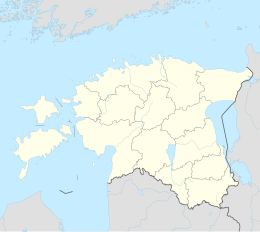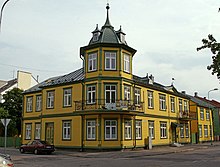Parnu
| Pärnu (German Pernau ) | |||
|
|||
| State : |
|
||
| Circle : |
|
||
| Founded : | 1251 | ||
| Coordinates : | 58 ° 23 ' N , 24 ° 31' E | ||
| Height : | 10 m | ||
| Area : | 858.07 km² | ||
| Residents : | 51,272 (2019-01-02) | ||
| Population density : | 60 inhabitants per km² | ||
| Time zone : | EET (UTC + 2) | ||
| Telephone code : | (+372) 44 | ||
| Postal code : | 80010-80401, 85009 | ||
| License plate : | F. | ||
| Community type: | city | ||
| Mayor : | Romek Kosenkranius
(independent) |
||
| Website : | |||
|
|
|||
Pärnu ( German Pernau ) is an Estonian port city with 51,272 inhabitants (2019) and an important seaside resort in the district of the same name .
geography
Pärnu is located at the mouth of the river of the same name . The city has a sandy beach about three kilometers long on the northern foothills of the Gulf of Riga .
history
The city was founded by the Teutonic Order in 1251 , and the Ordensburg was first mentioned around 1265. Pernau became a member of the Hanseatic League (very important as an ice-free port in Livonia ). It had been in Swedish ownership since the Livonian War in 1561 and experienced a cultural and economic heyday.
From 1699 to 1710 Pernau was the seat of the Dorpater University "Academia Gustavo Carolina". After the conquest of Pernau by Russian troops in the course of the siege of Pernau during the Great Northern War in the Peace of Nystad in 1721, the city came to the Russian Empire ( Gouvernement Livonia ). Even under Swedish rule, the city had already started to be developed into a fortress town, which was continued under Russian rule. In 1835 its status as a fortress city was revoked. In the 18th and 19th centuries, raw materials trading became increasingly important for Pernau. During the sea blockade in the Napoleonic era , the trading town fell into decline.
The University of Tartu (Dorpat) was temporarily located here from 1699 to 1710 and now has a college here (around 1,000 students in the 2004/05 academic year).
In 1838 the first bathing establishment opened its doors in Pärnu. In the following decades, a green belt with numerous parks was created on the site of the former fortress ring. Gradually, the city developed into a spa. The upswing of the spa business continued during the time of the Estonian Republic after 1920 and many spa guests also came from abroad, especially from Sweden, Germany and Latvia. Pernau was known as a spa and seaside resort with mud baths and long sandy beaches.
In 1939/40 - as stipulated in the Ribbentrop-Molotov Pact - the German residents of Pernau left the city. In 1940 it was occupied by the Red Army and part of the Estonian Soviet Republic . In July 1941 it was occupied by the German Wehrmacht . The city was largely destroyed by Soviet air raids and with the entry of the Red Army in September 1944. After the war, the old buildings were restored.
Even during the time of the Soviet Union , the spa business continued, despite considerable pollution of the water of the Pärnu River and the adjacent lake. One of the most famous spa guests was the violinist David Oistrach , who vacationed in Pärnu from 1954 to 1971. After Estonia regained independence, Pärnu was again named Estonia's “official summer capital” in June 1996. The water pollution was removed in 1993 with the construction of a modern sewage treatment plant.
In 2017 the municipalities of Estonia were restructured. This increased the area of Pärnu considerably and numerous surrounding villages were incorporated into the city proper.
population
| 1881 | 1897 | 1922 | 1934 | 1959 | 1970 | 1979 | 1989 | 2000 | 2009 | 2017 (1) | 2017 (2) |
|---|---|---|---|---|---|---|---|---|---|---|---|
| 12,966 | 12,898 | 18,499 | 20,334 | 22,367 | 50,224 | 54.051 | 53,885 | 46,476 | 44,024 | 39,497 | 50,426 |
| Figures 2017 before (1) and after (2) the reorganization of the municipalities | |||||||||||
tourism
The location, the climate and the beach have made Pärnu a popular spa and bathing resort since the opening of the first bathing establishment in 1838. Even today the city is occasionally referred to as the Estonian summer capital : At the beginning of the summer season, the mayor of Tallinn symbolically hands over the capital rights to the mayor of Pärnu. Most of the tourists are Estonians, Finns, Germans and - like before the Second World War - Swedes. The city has a large marina and an airport .
Culture and sights
Worth seeing in the old town are the Elisabeth and Katharinenkirche, the Red Tower, the Villa Ammende and the Tallinn (Revaler) Gate.
The international David Oistrach Festival takes place every summer in the city's new concert hall . The Pärnu International Documentary Film Festival also takes place in July . In June 2010, Pärnu, as a member of the " modern Hanseatic League ", also hosted the 30th International Hanseatic Days .
Monument to the proclamation of the independence of the Republic of Estonia
The Manifesto to All the Peoples of Estonia was read for the first time publicly on February 23, 1918 from the balcony of the Endla Theater and Society House, which at that time stood on the site of today's Hotel Pärnu. The monument symbolizes this balcony and the text is presented in different languages (including Braille).
Estonia Memorial
The memorial for those who died in 1994 when the ferry Estonia sank with a twelve meter high sculpture was created in 1997 by Mati Karmin and Tiit Trummal. A long granite-edged gravel bed leads to a raised square platform. A black memorial stone stands on top of it, above which a filigree black “canopy” rises from two interlocking “gates” made of steel. A slanted silver-plated steel cross floats in the canopy.
War cemeteries
In 1993 a German military cemetery was inaugurated near Pärnu as the final resting place for 960 fallen from both world wars. Nearby there is a cemetery with Estonian war dead from 1919/20.
Waffen SS war memorial
In 2002 the city had a war memorial erected, showing an Estonian soldier in the uniform of the Waffen-SS, pointing his rifle against Russia, with the inscription: »In memory of all Estonian soldiers who during the Second World War for the liberation of their homeland and for a free Europe 1940-1945. ”After protests, Romek Kosenkranikus, a representative of the city government, declared:“ The city is not very happy about the monument, but we are not rejecting it either. ”Later the monument was dismantled and im It was briefly rebuilt in the city of Lihula in August 2004 , before it was dismantled there after a few days and finally moved to a storage facility.
politics
coat of arms
Description : In blue a white cloud in the right upper corner , from which a red clad arm protrudes and holds a gold cross with cross arms slanted on one side. On the left is a golden key with a three-pass ridge pointing with the beard towards the center of the shield .
Town twinning
Pärnu has relationships with the following twin cities:
-
 Šiauliai (Lithuania), since 1992
Šiauliai (Lithuania), since 1992 -
 Jelgava (Latvia), since 1957
Jelgava (Latvia), since 1957 -
 Gran (Norway), since 1992
Gran (Norway), since 1992 -
 Helsingborg (Sweden), since 1989
Helsingborg (Sweden), since 1989 -
 Södertälje (Sweden), since 1989
Södertälje (Sweden), since 1989 -
 Oskarshamn (Sweden), since 1989
Oskarshamn (Sweden), since 1989 -
 Vaasa (Finland), since 1956
Vaasa (Finland), since 1956 -
 Helsingør (Denmark), since 1991
Helsingør (Denmark), since 1991 -
 Siófok (Hungary), since 1991
Siófok (Hungary), since 1991 -
 Ocean City , Maryland (USA), since 2003
Ocean City , Maryland (USA), since 2003 -
 Portsmouth , New Hampshire (USA), since 1999
Portsmouth , New Hampshire (USA), since 1999 -
 Sochi (Russia), since 1994
Sochi (Russia), since 1994
Further partnership relationships also exist
In addition, the city belongs to the New Hanseatic League and the Union of Baltic Cities .
traffic
Pärnu is located directly on the national road 4 from Riga to Tallinn , which is part of the European route 67 ( Via Baltica , Prague - Helsinki ). National road 5 , which leads to Rakvere , also begins here . Pärnu Airport is located in the northwest of the city . Between 1928 and December 9, 2018, there was a train connection with Tallinn, but this had to be discontinued due to the run-down infrastructure. The line leading to Riga had not been in operation for a long time.
education
In Pärnu there is a branch of the private Estonian Entrepreneurship University for Applied Sciences as well as the German Technology School Pärnu (Pärnu Saksa Tehnoloogiakool) of the Education & Craft Foundation .
sons and daughters of the town
- Georg Wilhelm Richmann (1711–1753), physicist
- Carl Gustav Jochmann (1789–1830), publicist
- Gustav Fabergé (1814–1893), goldsmith
- Friedrich Fromhold Martens (1845–1909), international lawyer
- Alexander Enmann (1856–1903), German-Baltic ancient historian
- Theodor Scheinpflug (1862–1919), German-Baltic pastor and Protestant martyr
- Hedda von Schmid (1864–1921), German writer
- Nicolai Guleke (1878–1958), German-Baltic surgeon
- Olev Siinmaa (1881–1948), architect
- Elisabeth Kaerrick (1886–1966), Dostoevsky translator into German
- Herbert Hahn (1890–1970), anthroposophist
- Jānis Kalniņš (1904–2000), composer
- Mart Port (1922–2012), architect
- Valter Ojakäär (1923–2016), composer, music journalist and musician
- Ivar Grünthal (1924–1996), poet
- Aleksander Loit (* 1925), Swedish historian of Estonian descent
- Els Oksaar (1926-2015), linguist
- Jaan Talts (* 1944), weightlifter
- Harry Jürgens (* 1949 in Pärnu; lives in Leipzig), graphic artist, illustrator and bookplate artist
- Jüri Mõis (* 1956), entrepreneur and politician
- Andrus Veerpalu (* 1971), cross-country skier
- Sergei Hohlov-Simson (* 1972), football player
- Marek Lemsalu (* 1972), football player
- Tõnis Kasemets (* 1974), racing car driver
- Indrek Zelinski (* 1974), football player
- Sergei Terehhov (* 1975), football player
- Kaido Külaots (* 1976), chess grandmaster
- Teet Allas (born 1977), soccer player
- Raio Piiroja (* 1979), football player
- Taavi Rähn (* 1981), soccer player
- Karl Palatu (* 1982), football player
- Kaire Palmaru (* 1984), soccer player
- Tanel Melts (* 1988), soccer player
- Sergei Mošnikov (* 1988), football player
- Rauno Alliku (* 1990), soccer player
- Jaak-Heinrich Jagor (* 1990), hurdler
- Triinu Esken (* 1992), soccer player
- Grete Ojala (* 1994), soccer player
Web links
- Visitor information
- Parnu Tourism
- Pictures from Pärnu and visitor information (German, English)
Individual evidence
- ^ Pärnu International Documentary Film Festival
- ↑ http://www.parnu2010.eu/index.php?id=1510&L=4 ( Memento from September 6, 2010 in the Internet Archive ) 30th International Hanseatic Days.
- ↑ visit estonia
- ^ Estonian veterans honor Waffen SS with a memorial Der Standard, July 23, 2003; Sara Toth: History debate in Estonian Parnu The Baltic Times / Deutsche Welle , 1. – 7. July 2002; Daniel Lazare: Timothy Snyder's Lies . Jacobin , September 9, 2014; Moscow outraged by the erection of the monument to Waffen SS legionaries in Estonia Sputnik News , September 7, 2018;
- ↑ Pärnu - Sõpruslinnad website ( page no longer available , search in web archives ), accessed on May 18, 2017
- ↑ 9. detsembrist hakkavad Lelle-Pärnu lõigul ronge asendama bussid (As of December 9, buses will replace the trains on the Lelle-Pärnu route). Elron , November 3, 2018, accessed December 23, 2018 (Estonian).
- ↑ http://www.eek.ee/index.php?pg=292&fil=par ( Memento from August 21, 2012 in the Internet Archive )
- ↑ Our branch in Estonia. Retrieved July 25, 2019 .











